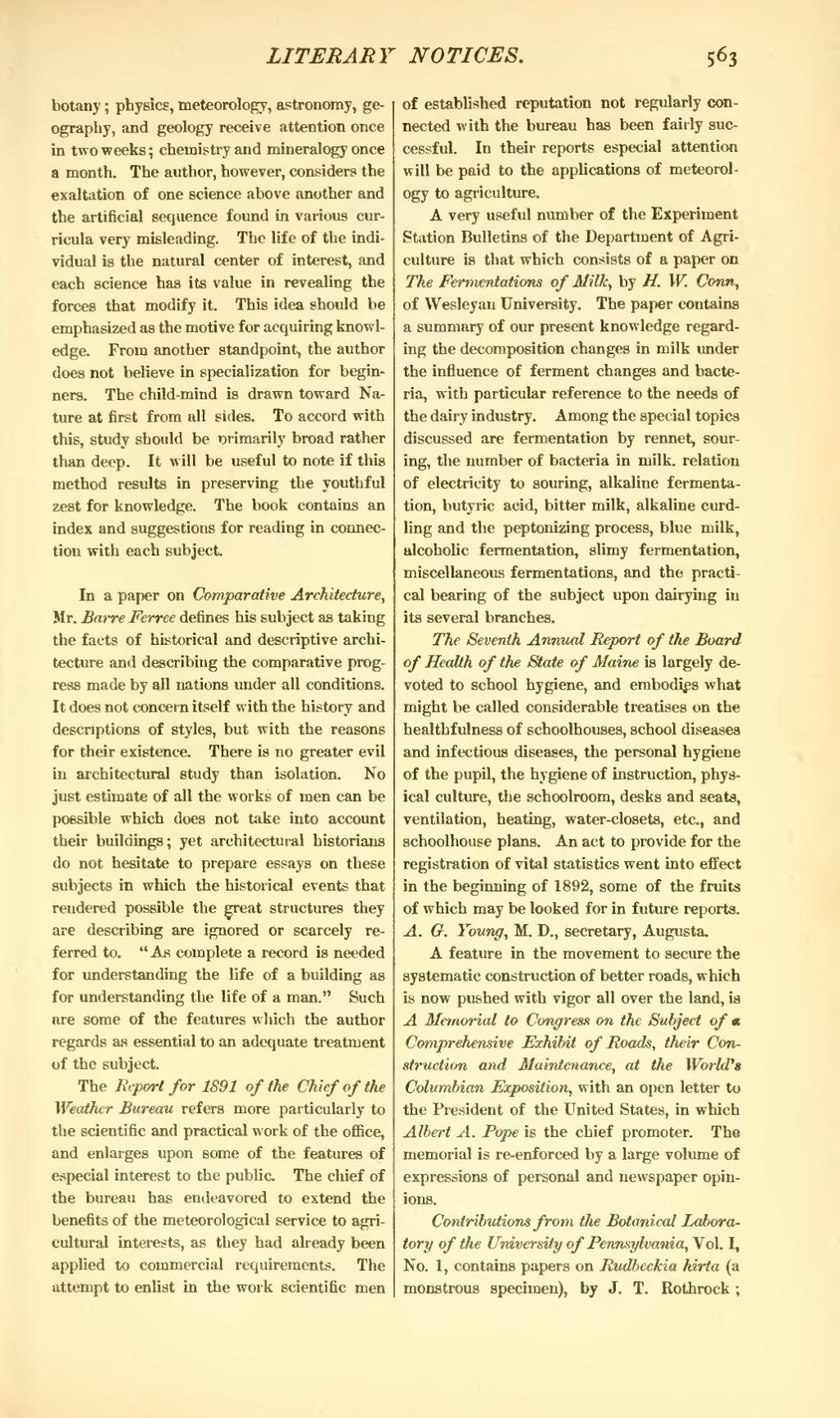botany; physics, meteorology, astronomy, geography, and geology receive attention once in two weeks; chemistry and mineralogy once a month. The author, however, considers the exaltation of one science above another and the artificial sequence found in various curricula very misleading. The life of the individual is the natural center of interest, and each science has its value in revealing the forces that modify it. This idea should be emphasized as the motive for acquiring knowledge. From another standpoint, the author does not believe in specialization for beginners. The child-mind is drawn toward Nature at first from all sides. To accord with this, study should be primarily broad rather than deep. It will be useful to note if this method results in preserving the youthful zest for knowledge. The book contains an index and suggestions for reading in connection with each subject.
In a paper on Comparative Architecture, Mr. Barre Ferree defines his subject as taking the facts of historical and descriptive architecture and describing the comparative progress made by all nations under all conditions. It does not concern itself with the history and descriptions of styles, but with the reasons for their existence. There is no greater evil in architectural study than isolation. No just estimate of all the works of men can be possible which does not take into account their buildings; yet architectural historians do not hesitate to prepare essays on these subjects in which the historical events that rendered possible the great structures they are describing are ignored or scarcely referred to. "As complete a record is needed for understanding the life of a building as for understanding the life of a man." Such are some of the features which the author regards as essential to an adequate treatment of the subject.
The Report for 1891 of the Chief of the Weather Bureau refers more particularly to the scientific and practical work of the office, and enlarges upon some of the features of especial interest to the public. The chief of the bureau has endeavored to extend the benefits of the meteorological service to agricultural interests, as they had already been applied to commercial requirements. The attempt to enlist in the work scientific men of established reputation not regularly connected with the bureau has been fairly successful. In their reports especial attention will be paid to the applications of meteorology to agriculture.
A very useful number of the Experiment Station Bulletins of the Department of Agriculture is that which consists of a paper on The Fermentations of Milk, by H. W. Conn, of Wesleyan University. The paper contains a summary of our present knowledge regarding the decomposition changes in milk under the influence of ferment changes and bacteria, with particular reference to the needs of the dairy industry. Among the special topics discussed are fermentation by rennet, souring, the number of bacteria in milk, relation of electricity to souring, alkaline fermentation, butyric acid, bitter milk, alkaline curdling and the peptonizing process, blue milk, alcoholic fermentation, slimy fermentation, miscellaneous fermentations, and the practical bearing of the subject upon dairying in its several branches.
The Seventh Annual Report of the Board of Health of the State of Maine is largely devoted to school hygiene, and embodies what might be called considerable treatises on the healthfulness of schoolhouses, school diseases and infectious diseases, the personal hygiene of the pupil, the hygiene of instruction, physical culture, the schoolroom, desks and seats, ventilation, heating, water-closets, etc., and schoolhouse plans. An act to provide for the registration of vital statistics went into effect in the beginning of 1892, some of the fruits of which may be looked for in future reports. A. G. Young, M. D., secretary, Augusta.
A feature in the movement to secure the systematic construction of better roads, which is now pushed with vigor all over the land, is A Memorial to Congress on the Subject of a Comprehensive Exhibit of Roads, their Construction and Maintenance, at the World's Columbian Exposition, with an open letter to the President of the United States, in which Albert A. Pope is the chief promoter. The memorial is re-enforced by a large volume of expressions of personal and newspaper opinions.
Contributions from the Botanical Laboratory of the University of Pennsylvania, Vol. I, No. 1, contains papers on Rudbeckia kirta (a monstrous specimen), by J. T. Rothrock;
